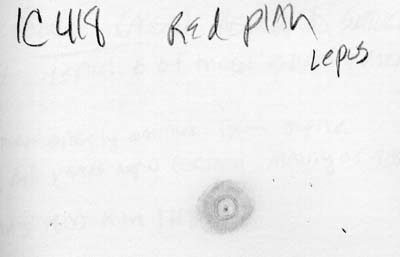
This planetary nebula is unique because some observers report it to appear red in the eyepiece. I've only seen red in large aperture telescopes, like Tom clark's 36-inch Yard Scope II in Fliorida and now in the Mt. Wilson 60-inch. The red is seen in the outer shell.
The APOD for September 30, 2001 says: What is creating the strange texture of IC 418? Dubbed the Spirograph Nebula for its resemblance to drawings from a cyclical drawing tool, planetary nebula IC 418 shows patterns that are not well understood. Perhaps they are related to chaotic winds from the variable central star, which changes brightness unpredictably in just a few hours. By contrast, evidence indicates that only a few million years ago, IC 418 was probably a well-understood star similar to our Sun. Only a few thousand years ago, IC 418 was probably a common red giant star. Since running out of nuclear fuel, though, the outer envelope has begun expanding outward leaving a hot remnant core destined to become a white-dwarf star, visible in the image center. The light from the central core excites surrounding atoms in the nebula causing them to glow. IC 418 lies about 2000 light-years away and spans 0.3 light-years across. This recently released false-color image taken from the Hubble Space Telescope reveals the unusual details.
Observed at 240X using the 100mm (4-inch diameter) Masiama Kellner eyepiece and 400x using the 4-inch diameter 60mm Erfle. To see the halo, we held a OIII filter between the eyepiece and our eye.

White Oaks Home | Sketches Index | Back | Next